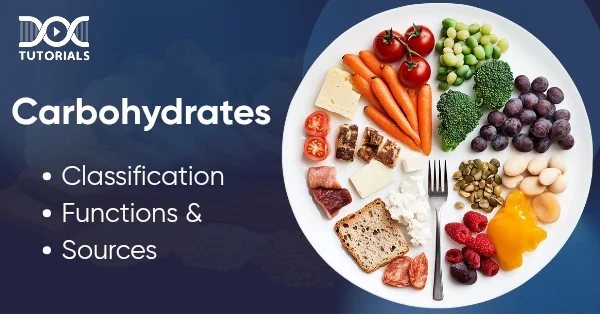Carbohydrates: Classification, Functions, and Sources

A group of organic compounds present in the form of sugar, cellulose, and starch in living tissues and food is called carbohydrates. Hydrogen and oxygen are present in 2:1 ratio in carbohydrates just like water. Carbohydrates break down when we eat them, releasing energy.
If you’re preparing for the NEET PG exams, the classification of carbohydrates is a crucial part of the syllabus. If you are one of them, continue reading for detailed insights into carbohydrate types, functions, and sources.
What are Carbohydrates, and How are They Classified?
Carbohydrates are energy-giving macronutrients, chemically made up of hydrogen, oxygen, and carbon. Foods rich in fibres, sugars, and starches contain carbohydrates in huge amounts. When your digestive system digests these foods, they produce glucose or blood sugar.
This sugar is an energy source for our tissues, organs, and cells. The additional sugar or energy is stored in an individual’s liver and muscles for further use.
Based on their chemical structure, carbohydrates are classified into the following 2 types:
- Simple Carbohydrates
Simple carbohydrates break down into molecules quickly and convert them into sugar. Beer, refined sugars, milk products, fruits, etc., contain one or two sugar molecules. Because these carbohydrates do not possess vitamins, minerals, or fibre, they are called empty calories.
Simple carbohydrates are divided into the following:
- Monosaccharides
Glucose, fructose, mannose, galactose, etc., are examples of monosaccharides. They are further classified into trioses (each molecule made of three carbon atoms), tetroses (four atoms), pentoses (five atoms), hexoses (six atoms), and heptoses (seven atoms).
- Disaccharides
The combination of two monosaccharides is called a disaccharide. Lactose, sucrose, maltose, etc., are examples of disaccharides.
- Oligosaccharides
Oligosaccharides are carbohydrates from two to nine linked sugar units, including trioses, pentoses, and hexoses.
- Complex Carbohydrates
Complex carbohydrates are made of two or more sugar molecules. They are primarily found in starchy foods and are digested more slowly than simple carbohydrates.
Complex carbohydrates are mostly found in beans, potatoes, lentils, peanuts, whole-grain breads, corn, peas, etc. One of the common examples of complex carbohydrates is polysaccharides.
- Polysaccharides
Large, complex carbohydrates called polysaccharides are created when several glucose molecules are polymerised together. Examples like starch, glycogen, and cellulose are highly branched and consist solely of glucose monomers.
Starch consists of 2 parts: amylose, a straight chain, and amylopectin, which is highly branched. Glycogen, often called animal starch, resembles starch but is even more branched.
Conversely, cellulose is a fibrous polysaccharide that provides structural support in plant cell walls. Unlike starch and glycogen, cellulose is a straight, unbranched polymer with great strength and rigidity.
What are the Functions of Carbohydrates?
Here are some of the notable functions of carbohydrates:
- Uplifts the Mood
As per studies, carbohydrates produce a neurotransmitter called serotonin that boosts positive emotions. Low serotonin levels can affect your mental health and cause depression.
- Provides Energy
Our body requires energy to perform all types of physical activities, such as walking, running, lifting, and even breathing. Carbohydrates provide this energy for physical and mental activities.
- Helps Lose Weight
If your food contains enough dietary fibre and complex carbohydrates, you can cut off extra calories. This diet also helps improve your metabolism and lose body fat.
- Helps Build Muscles
Carbohydrates are crucial for supplying energy during intense exercise and restoring glycogen levels after workouts in bodybuilding. Consuming carbohydrates along with protein can boost muscle protein synthesis, which helps with muscle growth and repair.
- Helps in Digestion
Dietary fibres are rich in carbohydrates and help maintain a healthy gut, prevent constipation, promote efficient waste removal, and reduce other digestive issues.
- Reduces Chronic Diseases
Some rich carbohydrate sources include fruits, whole grains, vegetables etc. Consuming such foods can reduce the risks of type 2 diabetes, heart disease, and cancers (specific types).
- Help Improve Athletic Performance
Eating carbohydrates before and after exercise helps fuel your body for activity and supports faster muscle recovery, which can lead to better athletic performance.
What are the Sources of Carbohydrates?
The following are the main sources of carbohydrates:
- Fruits
Apples, berries, bananas, melons, and oranges are excellent sources of fibre, carbohydrates, vitamins, and minerals sources.
- Whole Grains
Whole grains, such as quinoa, whole wheat bread, brown rice, barley, and oats, are rich in complex carbohydrates.
- Legumes
Chickpeas, lentils, kidney beans, and black beans are rich in protein and carbohydrates. Adding them to your diet ensures a healthy, wholesome diet.
- Vegetables
Vegetables containing starch, such as corn, squash, potatoes, peas, and sweet potatoes, are great carbohydrates. Moreover, non-starchy vegetables like spinach, green beans, and broccoli also provide carbohydrates.
- Dairy Products
Dairy products like cheese, yoghurt, and milk contain carbohydrates and calcium. The carbohydrates in dairy products are stored as lactose.
For better health, try to eat mostly whole, unprocessed foods. Balance your carbohydrates with protein, healthy fats, and fibre to support your overall well-being.
FAQs About Carbohydrates
- What are the different types of carbohydrates?
Carbohydrates in foods include fibre, starch, and sugars. Fibre and starches are complex carbohydrates, while sugars are simple carbohydrates. “Total carbohydrates” on food product labels combines all 3 types.
- What is the main function of carbohydrates in your body?
Carbohydrates are your body’s primary source of energy. They help fuel your brain, kidneys, heart muscles, and central nervous system. Fibre is a carbohydrate that aids in digestion, helps you feel full, and keeps blood cholesterol levels in check.
- What is the daily carbohydrate intake level recommended by experts?
There’s no universal daily carb recommendation, as your ideal intake depends on factors like age, health, activity, and goals. The USDA (United States Department of Agriculture) suggests filling half your plate with fruits and vegetables, a quarter with whole grains, and a quarter with protein.
Conclusion
Carbohydrates are vital nutrients classified as monosaccharides, disaccharides, and polysaccharides. They serve as the body’s primary energy source, support various bodily functions, and aid in muscle recovery. Major sources include grains, fruits, vegetables, and legumes, making carbohydrates essential to a balanced, healthy diet.
Carbohydrates are a crucial topic for NEET PG aspirants. With DocTutorials’ NEET PG study materials, top-grade video lectures, QRP (Quick Revision Programs), etc., you can learn more about the classification of carbohydrate. Want to secure top rank in NEET PG? Enrol in our NEET PG course today!
Latest Blogs
-

NEET PG Exam 2025- Date, Pattern, Marking Scheme, Subject Wise Weightage, and Exam Mode
NEET PG Exam 2025 is the ultimate gateway for medical graduates aspiring to pursue postgraduate courses in medicine, including MD,…
-

INI CET Exam 2025: Your Roadmap to Success – Key Topics, Strategies, and Lessons from Last Year’s Papers
The INI CET exam is more than just a test; it’s a significant milestone for many medical students aiming to…
-

INI CET Exam Success: Previous Year Question Papers & Ultimate Guide – INI CET PYQ
One can feel overwhelmed while preparing for the INI CET (Institute of National Importance Combined Entrance Test). A vast syllabus,…




